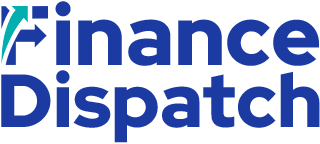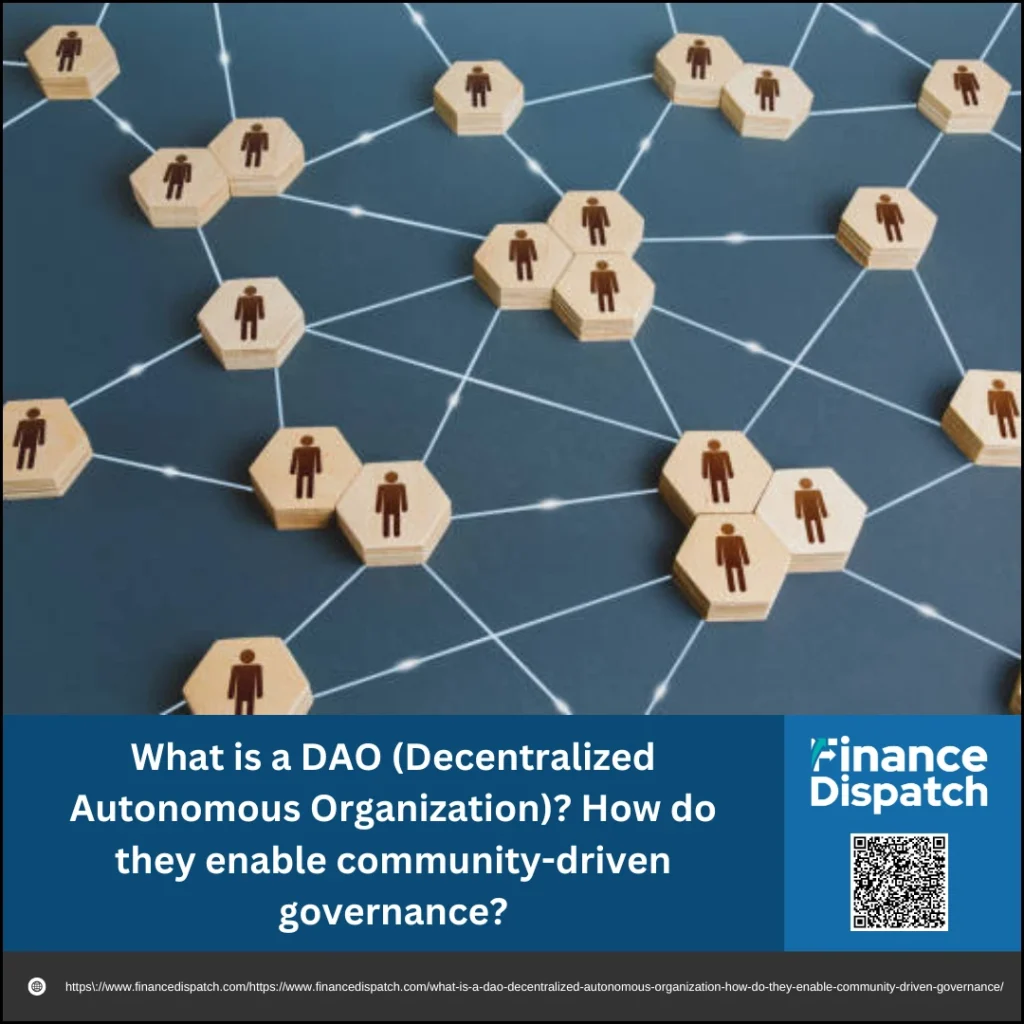In a world increasingly shaped by digital innovation, the concept of governance is evolving beyond traditional institutions. At the forefront of this transformation is the Decentralized Autonomous Organization (DAO)—a blockchain-based structure that redefines how communities collaborate, make decisions, and manage resources. Unlike conventional organizations led by centralized authority figures, DAOs operate through transparent smart contracts and collective member input, enabling a more inclusive and participatory form of governance. This article explores what a DAO is, how it functions, and how it empowers communities to take control of decision-making in a truly decentralized and democratic manner.
What is a DAO?
A DAO, or Decentralized Autonomous Organization, is a blockchain-based entity governed by smart contracts and the collective decisions of its members rather than a central authority. It operates through a set of transparent, coded rules that automatically execute decisions once agreed upon by the community, typically through a token-based voting system. Members hold governance tokens that represent their voting power, allowing them to propose, deliberate, and vote on various organizational actions. This structure enables DAOs to function autonomously and fairly, promoting a more democratic and community-driven approach to organizational management.
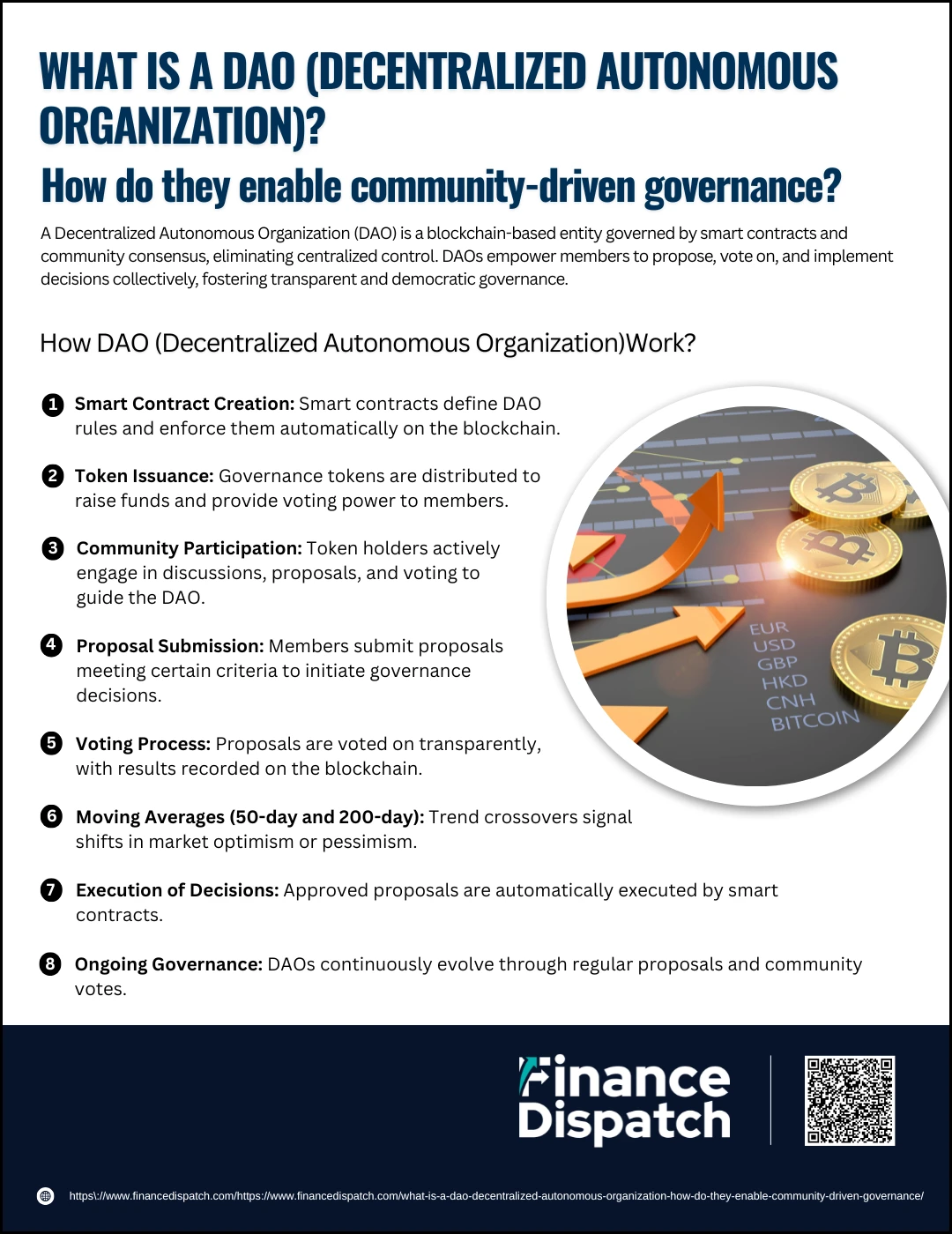 How DAOs Work
How DAOs Work
Decentralized Autonomous Organizations (DAOs) are designed to operate without centralized leadership, relying instead on blockchain-based protocols and collective governance. These organizations function through a predefined set of rules coded into smart contracts and are maintained by a community of stakeholders who participate in decision-making. Below is a detailed step-by-step explanation of how a DAO works:
1. Smart Contract Creation
The foundation of any DAO lies in its smart contracts—self-executing code deployed on a blockchain, typically Ethereum. These smart contracts define the core functions of the organization, including governance mechanisms, membership rules, proposal submission processes, and treasury management. Once deployed, these contracts become immutable, meaning they cannot be changed without a community vote. This ensures transparency and trust in how the DAO operates.
2. Token Issuance
After setting the foundational rules, the DAO issues governance tokens. These tokens serve multiple purposes: they raise funds for the DAO, represent ownership stakes, and grant voting rights to holders. Depending on the DAO’s structure, tokens may be sold to the public, distributed through community contributions, or earned by performing tasks for the DAO. The number of tokens a member holds often determines their influence within the organization.
3. Community Participation
Individuals who hold the DAO’s tokens become its active members. This community forms the core decision-making body of the DAO. Members are encouraged to participate by proposing ideas, discussing potential projects, and voting on key decisions. The decentralized nature of DAOs allows anyone with tokens—regardless of location or background—to engage in governance, fostering a diverse and inclusive ecosystem.
4. Proposal Submission
Members can submit formal proposals to suggest changes, launch initiatives, allocate funds, or modify existing protocols. These proposals are submitted through the DAO’s platform and must meet predefined criteria set in the smart contracts—such as a minimum token threshold or support from a certain number of members—to move forward to a voting phase.
5. Voting Process
Once a proposal qualifies, it is opened up for voting. Token holders cast their votes based on their token holdings, although some DAOs may implement alternative voting models like quadratic voting to prevent power concentration. The voting process is typically time-bound and fully transparent, with all votes recorded on the blockchain to ensure immutability and accountability.
6. Execution of Decisions
If a proposal receives enough support to pass, the smart contract automatically enforces the approved action. For example, if the proposal was to allocate funds to a development team, the contract would transfer the specified amount from the DAO’s treasury without manual intervention. This eliminates the need for trusted intermediaries and reduces the risk of human error or corruption.
7. Ongoing Governance
A DAO is a continuously evolving entity. Members regularly submit new proposals, participate in voting rounds, and update the organization’s rules as needed. The system is designed to be adaptable, allowing the DAO to respond to changing community needs or external circumstances. Active governance ensures the DAO remains aligned with its mission and remains resilient over time.
Key Components of a DAO
At the heart of every DAO are several core components that work together to ensure decentralized governance and smooth operation. These elements are typically built using blockchain technology, enabling transparency, trust, and automation. Each component plays a specific role, from defining the rules to enabling participation and managing shared assets. Below is a table outlining the essential building blocks of a DAO:
| Component | Description |
| Smart Contracts | Self-executing code that defines the DAO’s rules, automates operations, and eliminates the need for intermediaries. |
| Governance Tokens | Digital assets that represent voting power; used by members to participate in decision-making. |
| Treasury | A blockchain-based pool of funds collectively owned and managed by the DAO community through voting. |
| Proposals | Formal suggestions made by members to introduce changes, allocate funds, or modify rules. |
| Voting Mechanism | The process through which members cast votes on proposals, often weighted by token holdings or using alternative models like quadratic voting. |
| Community Members | Token holders who participate in the DAO by proposing ideas, voting, and contributing to the organization’s growth. |
Types of DAOs Real-World Use Cases
As the concept of decentralized governance has evolved, various types of DAOs have emerged to serve different purposes across industries—from finance and philanthropy to media and social networking. Each type of DAO is tailored to a specific goal but shares a common foundation of collective decision-making, smart contract automation, and token-based governance. Below are the most prominent types of DAOs along with real-world examples demonstrating their practical applications.
1. Investment DAOs
These DAOs pool member funds to invest in assets such as startups, NFTs, or cryptocurrencies.
Example: The DAO (2016), MetaCartel Ventures.
2. Grant DAOs
Created to fund public goods, research, or projects in the crypto ecosystem through community-approved grants.
Example: Gitcoin DAO, MolochDAO.
3. Protocol DAOs
Used to govern decentralized protocols or DeFi platforms. Members vote on upgrades, parameter changes, and ecosystem developments.
Example: Uniswap DAO, MakerDAO.
4. Social DAOs
Built around shared interests, these DAOs focus on community-building, networking, and collaboration.
Example: Friends With Benefits (FWB), Krause House (a DAO aiming to buy an NBA team).
5. Collector DAOs
Focused on acquiring, curating, and managing digital art or NFTs as a group.
Example: FlamingoDAO, PleasrDAO.
6. Media DAOs
Democratize content creation and curation by allowing members to fund, produce, and govern media platforms.
Example: Bankless DAO, Forefront.
7. Philanthropy DAOs
Organize charitable donations and community-impact initiatives, distributing funds transparently based on collective voting.
Example: Big Green DAO, Endaoment.
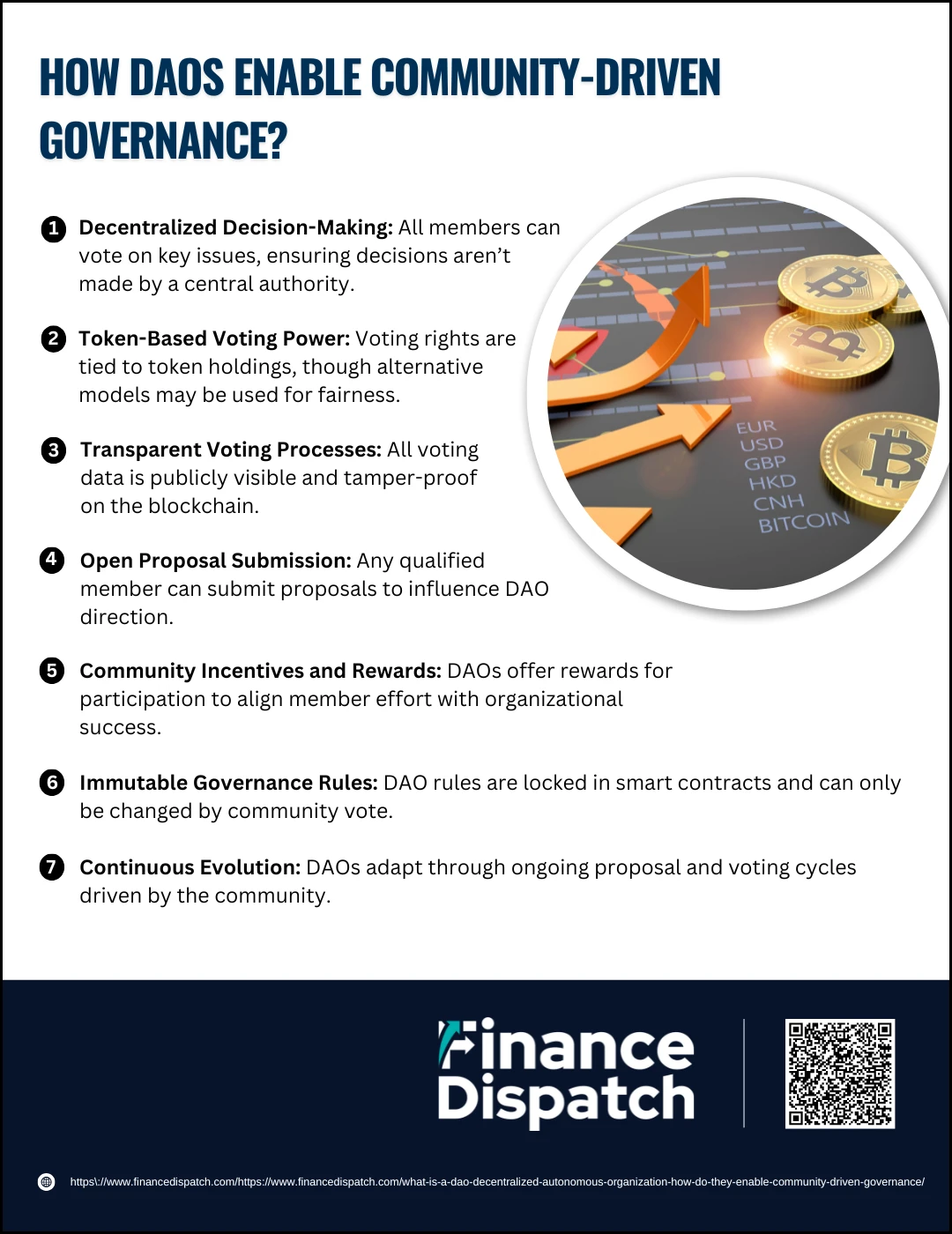 How DAOs Enable Community-Driven Governance
How DAOs Enable Community-Driven Governance
DAOs represent a groundbreaking shift in how communities can organize and make decisions. By removing centralized control and relying on transparent, rule-based systems, DAOs empower individuals to collectively shape the direction and actions of an organization. This structure not only ensures that power is distributed among all participants but also builds trust through open participation and immutable recordkeeping. Below is a more detailed look at how DAOs achieve truly community-driven governance:
1. Decentralized Decision-Making
In traditional organizations, decisions are often made by a small group of executives or board members. In contrast, DAOs allow any member to participate in governance. All major decisions—from budget allocation to strategic direction—are determined through proposals and community votes. This removes centralized bottlenecks and fosters a democratic environment where each voice counts.
2. Token-Based Voting Power
Governance tokens are at the core of DAO participation. These tokens are distributed to members, typically based on contributions, purchases, or early involvement. Token holders can vote on proposals, with their voting power often proportional to the number of tokens they own. While this system enables active participation, some DAOs implement alternative models like quadratic voting to reduce the influence of large holders and promote fairness.
3. Transparent Voting Processes
All voting activity in a DAO is recorded on the blockchain, making the entire process verifiable and tamper-proof. Members can see which proposals were submitted, how others voted, and the final outcome—ensuring decisions are made openly and without behind-the-scenes manipulation. This transparency builds community trust and fosters accountability.
4. Open Proposal Submission
DAOs encourage community members to take initiative. Any member who meets certain criteria—like holding a minimum number of tokens—can submit a proposal. These proposals can cover anything from funding new projects to changing governance rules. This open-access approach ensures that innovation and new ideas come from the bottom up, rather than being imposed from the top down.
5. Community Incentives and Rewards
Many DAOs incorporate reward systems to encourage ongoing participation. Members may earn additional tokens, reputation points, or other benefits for contributing to discussions, voting on proposals, or completing tasks. These incentives not only keep members engaged but also align individual motivation with the success of the DAO.
6. Immutable Governance Rules
The operational rules of a DAO are written into smart contracts and deployed on the blockchain. These contracts are tamper-resistant, meaning no single person or group can alter them without going through the governance process. This ensures consistent rule enforcement and protects against arbitrary or corrupt actions, strengthening the DAO’s integrity.
7. Continuous Evolution
While the smart contracts enforce current rules, DAOs are designed to evolve over time. Members can propose amendments to governance processes, changes in funding strategies, or new use cases for the organization. Through a continuous cycle of proposals and voting, DAOs remain agile and responsive to the needs of their communities and external conditions.
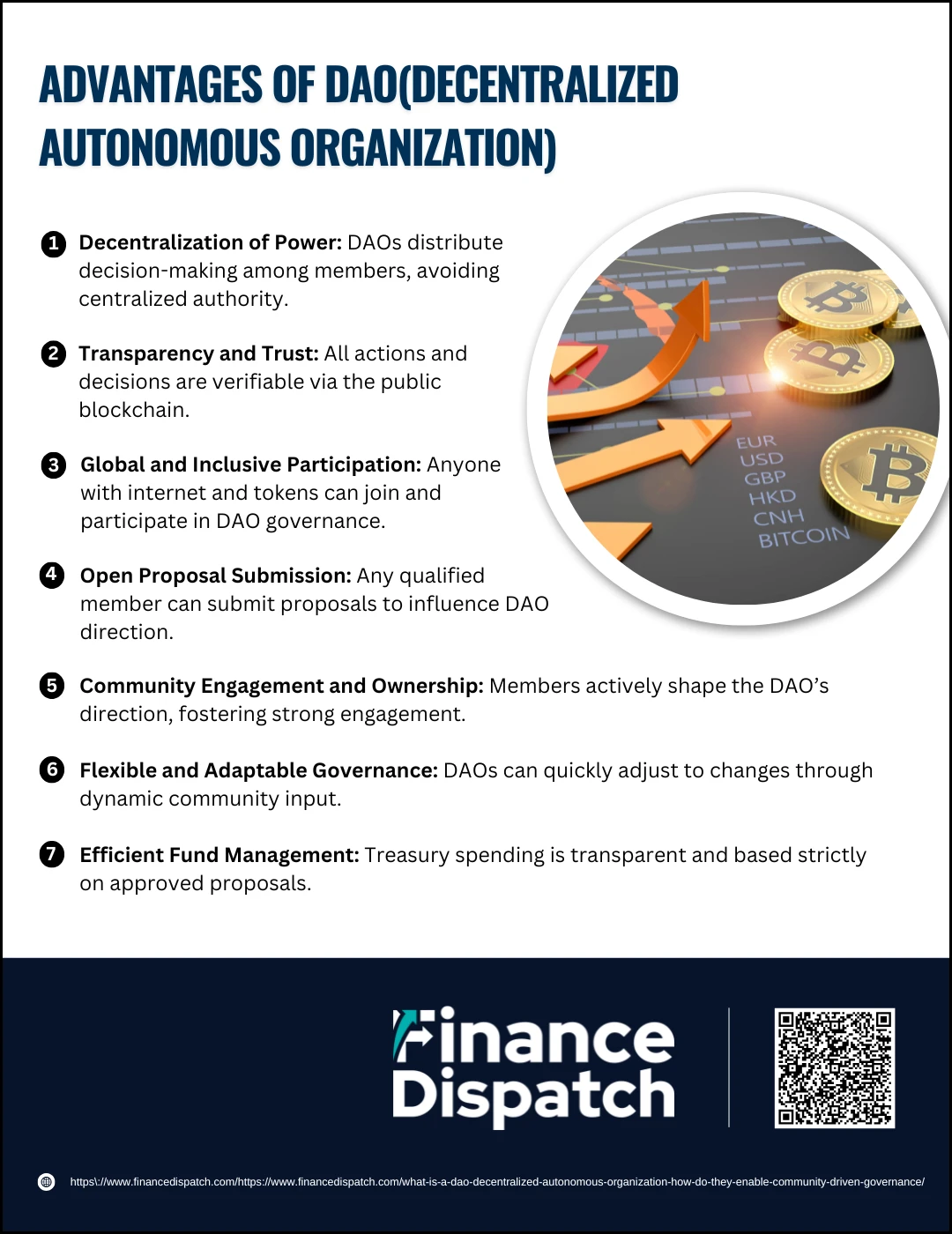 Advantages of DAOs
Advantages of DAOs
Decentralized Autonomous Organizations (DAOs) represent a significant shift in how people collaborate and make collective decisions. Unlike traditional organizations with rigid hierarchies and centralized control, DAOs are built on transparent blockchain protocols and governed by the community. This structure offers a wide range of advantages, making DAOs an appealing model for decentralized governance, investment, and innovation. Below are the key benefits of DAOs, explained in more detail:
1. Decentralization of Power
In traditional setups, a small leadership group holds most of the decision-making authority. DAOs disrupt this by distributing power among all token holders. Every member has a voice and can contribute to shaping the organization’s future, which reduces the risks of centralized abuse, censorship, or unilateral control.
2. Transparency and Trust
All DAO activities—including proposal submissions, voting outcomes, and fund allocations—are recorded on a public blockchain. This means any member can verify the actions taken by the DAO, promoting honesty and accountability. The visibility of decision-making builds trust among participants, especially in global, trustless environments.
3. Global and Inclusive Participation
DAOs are accessible to anyone with an internet connection and the relevant governance tokens. There are no geographical, political, or institutional barriers to joining. This inclusivity encourages participation from a diverse, global pool of individuals who bring unique perspectives and ideas to the table.
4. Automation through Smart Contracts
One of the most powerful features of a DAO is its reliance on smart contracts—self-executing code that enforces rules and carries out actions automatically once certain conditions are met. This reduces the need for manual processes, minimizes delays, and eliminates the risk of human error or interference in executing community-approved actions.
5. Community Engagement and Ownership
DAO members are more than passive users; they are active stakeholders with voting rights and shared responsibilities. This sense of ownership fosters deep engagement, as members are more motivated to participate, contribute ideas, and advocate for the long-term success of the DAO.
6. Flexible and Adaptable Governance
DAOs are designed to evolve. Unlike rigid corporate structures, a DAO can adapt quickly to new technologies, market shifts, or community needs. Members can propose changes, vote on new directions, or update governance models, ensuring the organization stays relevant and resilient over time.
7. Efficient Fund Management
DAO treasuries are governed collectively, with funds released only when a proposal is approved through a transparent voting process. This prevents misuse of resources and ensures that capital is allocated according to the will of the community. Additionally, blockchain records make it easy to track every transaction and audit spending.
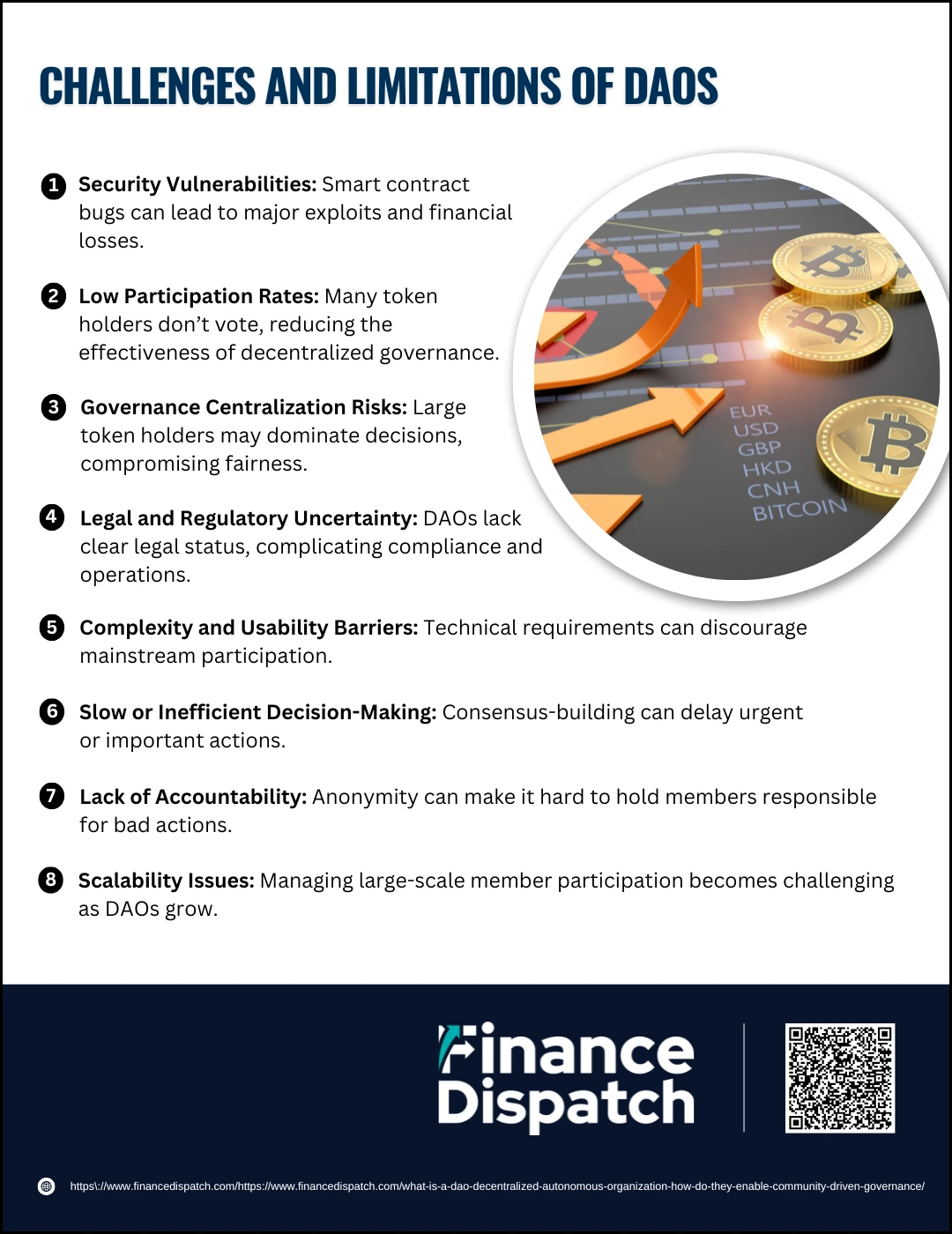 Challenges and Limitations of DAOs
Challenges and Limitations of DAOs
While DAOs offer a promising vision for decentralized governance and collective decision-making, they are not without their challenges. As a relatively new concept, many DAOs are still navigating the complexities of community management, security, legal recognition, and scalability. Understanding these limitations is crucial for building stronger, more resilient DAOs and for setting realistic expectations about their role in shaping the future of organizations.
1. Security Vulnerabilities
Smart contracts are immutable, meaning once deployed, they cannot be easily altered. If the code contains bugs or is poorly written, it can be exploited—resulting in significant financial losses or governance failures. A well-known example is The DAO hack in 2016, where over $60 million in funds were drained due to a vulnerability in the contract code.
2. Low Participation Rates
While DAOs are open to all token holders, in practice, only a small percentage of members actively participate in governance. Voter apathy can lead to decisions being made by a vocal minority, undermining the goal of true decentralization and skewing outcomes in favor of larger stakeholders.
3. Governance Centralization Risks
Although DAOs are designed to be decentralized, token-based voting systems often lead to concentration of power in the hands of a few large token holders. This can replicate traditional hierarchies and diminish the influence of smaller participants, creating inequality within the governance process.
4. Legal and Regulatory Uncertainty
Most jurisdictions do not yet recognize DAOs as legal entities. This creates ambiguity around issues like liability, taxation, intellectual property, and contractual obligations. Without legal clarity, DAOs may face challenges when interfacing with traditional institutions or complying with national laws.
5. Complexity and Usability Barriers
For many newcomers, engaging with a DAO can be confusing. The need to understand blockchain wallets, tokenomics, proposal processes, and voting mechanisms can be intimidating and discouraging—limiting the accessibility and growth of DAO communities.
6. Slow or Inefficient Decision-Making
Democratic governance through community voting can be time-consuming, especially when urgent actions are needed. Reaching consensus among diverse participants often involves lengthy discussions and multiple voting rounds, which may delay implementation.
7. Lack of Accountability
In anonymous or pseudonymous communities, holding individuals accountable for their actions can be difficult. This can lead to irresponsible behavior, manipulation of proposals, or mismanagement of funds without clear consequences for those involved.
8. Scalability Issues
As DAOs grow, coordinating thousands of members becomes increasingly complex. Managing proposals, discussions, and votes at scale can strain the DAO’s infrastructure and community engagement, requiring new tools and governance innovations to maintain effectiveness.
DAO Governance Models
Governance is at the core of every DAO, shaping how decisions are made and who gets to influence them. Different DAOs adopt various governance models depending on their goals, community size, and desired level of decentralization. Each model offers unique advantages and trade-offs—balancing efficiency, fairness, participation, and security. Understanding these governance frameworks is essential for designing sustainable and inclusive DAOs.
| Governance Model | Description | Pros | Cons |
| Token-Based Voting | Members vote in proportion to the number of governance tokens they hold. | Simple and widely used; easy to implement. | Can lead to plutocracy where wealth equals influence. |
| Quadratic Voting | Voting power increases at a diminishing rate relative to the number of tokens. | Reduces influence of large holders; promotes fairness. | More complex and may require additional technical setup. |
| Reputation-Based Voting | Voting rights are earned based on contributions or activity within the DAO. | Rewards merit and meaningful participation. | Hard to quantify reputation accurately and transparently. |
| Delegated Voting | Members delegate their votes to trusted representatives or experts. | Efficient decision-making; reduces voter fatigue. | Risk of centralizing power among a few delegates. |
| Multisig Governance | A group of pre-selected members must all sign off on actions or proposals. | Secure and efficient for smaller DAOs or treasuries. | Not scalable; reduces community participation and input. |
Future Outlook for DAOs
As blockchain technology matures and decentralized systems gain wider acceptance, DAOs are poised to play a transformative role in how organizations are structured and governed. The future of DAOs will likely see increased adoption across industries such as finance, media, philanthropy, and even government. Improvements in user experience, voting mechanisms, legal recognition, and security will help address current limitations and make DAOs more accessible to mainstream users. We may also see the rise of cross-chain DAOs, AI-assisted governance tools, and hybrid models that blend on-chain and off-chain processes. As communities continue to seek transparent, inclusive, and autonomous ways to collaborate, DAOs are expected to evolve from experimental projects into foundational components of the digital economy.
Conclusion
Decentralized Autonomous Organizations (DAOs) represent a powerful shift in how communities can organize, govern, and create value together. By removing centralized control and relying on blockchain-based smart contracts, DAOs enable transparency, collective decision-making, and global participation. While they still face challenges like legal ambiguity, security risks, and participation hurdles, their potential to redefine collaboration is undeniable. As the technology and governance models continue to evolve, DAOs are likely to become an integral part of the digital future—empowering individuals to co-create and manage organizations with greater fairness, efficiency, and accountability.
